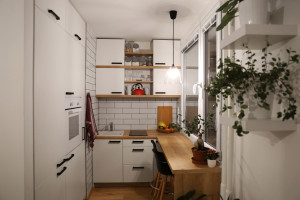With an increasing population of nuclear or small families in India, the trend of Compact Home is extending energy in the realty market of the country. Remarkably, in the metropolitan cities where more than half of the population is working, these homes represent a very significant part as they are closer to business districts and above all are much affordable in price.
A compact home is composed of a hall, bedroom, study and a kitchen with washrooms and balcony. These houses differ in size from 500 sq. ft. to 800 sq. ft. which is well-suited for a tiny family. Compact Living is conclusively smart living, where build space is inadequate, yet the quality of facilities and design remain high. It tends to be more commonplace in countries where space comes at a premium price, for e.g. the Netherlands.
Real estate experts state that in cities like Delhi, Mumbai, Bangalore, Chennai, and Kolkata, where land is minimum and prices are steep, the concept of compact homes has scaled up a lot. Also, selling a high and luxury apartment can be much challenging for the developers and due to which they are in approval of launching small-sized apartments that not only decrease the cost but are also space-efficient to satisfy the requirements of the homebuyer.
Advantages of Compact Homes for Homebuyers
To accomplish their financial goals and protect their earnings, nuclear families, millennials these days favor financing compact homes. Apart from that, a compact home comes with a variety of advantages which incorporates well-defined advantage of space and additional propositions.
Thoughtful Construction
A compact home is BuiltWith smart construction and excellent space utilization. Although it is small in area and size they are created in such a way that it comfortably supports every essential necessity of a home without misusing any part of it. These houses are built having in mind the latest technologies, interiors and other décor trends.
Cheap Maintenance
As numerous working professionals invest in compact homes, they prefer a home with comfort and low maintenance cost. There are numerous cost-effective methods to maintain a compact home than a big-sized apartment. Also, a home buyer has to pay less on furniture, other décor items and has to pay less for electricity and additional bills and charges.
Design Home your own way
Compact homes provide you the freedom to design and decorate your dream home in your own way. These days families want to give the best look to their home with innovative and compact furniture, stylish décor items, etc.
Budget-friendly Price
Due to small size, these homes come at a relatively cheaper price as compared to traditional apartments. Also, with the central Government concentrating more on ‘Housing for all’, more and more developers are constructing such units to attract home buyers. Also, you don’t have to compromise on sound infrastructure, amenities, and facilities.
Good Resale Value
With an expansion in trend and market for compact homes in today’s real estate landscape, more people are looking for such projects which facilitate such units. Because of this, the resale advantages of such units are more associated with spacious apartments. These houses are sold off very fast and hence offer better Returns on Investment to the property owner. Compact Living offers a living where one compromises on space, yet still enjoy the merits of living in a prime city location, with quality design at an affordable price.
Within Bengaluru, areas like North Bengaluru, Whitefield, Sarjapura Road, and Hosur Road are recognized as preferable locations for compact housing projects. Their vicinity to the city’s tech and economic hubs presents them as preferred locations considering the confined customer market. North Bengaluru has emerged as the clear winner, as the region that has witnessed the launch of many Compact Housing projects in the previous years.
It is obvious that the compact housing section will improve in the following years. With more knowledge about the product, its long-term advantages, and more immeasurable resale value, compact housing will arise as a more powerful segment. It has tremendous business potential and is demanded to apprehend at least 25% of the whole addressable market (16,000 units) by the year 2020.
Are Compact Homes the Future of Indian Real Estate?
Today’s generation requires smart spaces with ease of furnishing. India is on its approach to grow into the world’s youngest nation. Our youth stimulates our economy, and the real estate segment is accurately in the midst of this growth path. Nevertheless, it’s not just a transformation in preferences. Another compelling idea following today’s generation turning towards compact housing is the sky-high costs, non-availability of land, and the Indian government’s “Housing for All by 2022” initiative.
Developers are also making a conscious effort to develop affordable houses for lower and middle-income groups and thus deliver the dream of owning a house to everyone.
The influx of young professionals in Tier I and Tier II cities
In the preceding decade, cities like Bengaluru, Mumbai, Delhi, NCR, and Chennai have seen an enormous influx of young professionals aged between 25-34, thereby, managing to a rush in demand for residential properties. Interestingly, these cities also appear to be the destinations that require large land parcels, which paves a way for efficient houses, with modern features, if not a huge floor plan.
The “Pradhan Mantri Awas Yojana” factor
The government intends to build about 20 million affordable houses by March 2022, which has moreover cemented the position of compact housing in Indian real estate. These houses are equipped with all basic amenities, along with being affordable and compact. Not to mention, they arrive at reduced rates and a fleet of incentives. All the before-mentioned factors associate themselves with the future of Indian real estate that concentrates principally on compact housing. With a stronghold on today’s real estate and tremendous business potential, the compact housing segment is particularly expected to expand in the following years.
Image Source: google




